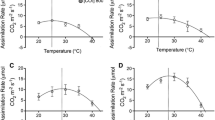Abstract
The aim of this study was to characterise growth and photosynthetic capacity in plants adapted to long-term contrasting atmospheric CO2 concentrations (C a). Seeds of Agrostis canina L. ssp. monteluccii were collected from a natural CO2 transect in central-western Italy and plants grown in controlled environment chambers at both ambient and elevated CO2 (350 and 700 μmol mol−1) in nutrient-rich soil. Seasonal mean C a at the source of the plant material ranged from 610 to 451 μmol CO2 mol−1, derived from C4 leaf stable carbon isotope discrimination (δ13C). Under chamber conditions, CO2 enrichment stimulated the growth of all populations. However, plants originating from elevated C a exhibited higher initial relative growth rates (RGRs) irrespective of chamber CO2 concentrations and a positive relationship was found between RGR and C a at the seed source. Seed weight was positively correlated with C a, but differences in seed weight were found to explain no more than 34% of the variation in RGRs at elevated CO2. Longer-term experiments (over 98 days) on two populations originating from the extremes of the transect (451 and 610 μmol CO2 mol−1) indicated that differences in growth between populations were maintained when plants were grown at both 350 and 700 μmol CO2 mol−1. Analysis of leaf material revealed an increase in the cell wall fraction (CWF) in plants grown at elevated CO2, with plants originating from high C a exhibiting constitutively lower levels but a variable response in terms of the degree of lignification. In vivo gas exchange measurements revealed no significant differences in light and CO2 saturated rates of photosynthesis and carboxylation efficiency between populations or with CO2 treatment. Moreover, SDS-PAGE/ LISA quantification of leaf ribulose bisphosphate carboxylase/oxygenase (Rubisco) showed no difference in Rubisco content between populations or CO2 treatments. These findings suggest that long-term adaptation to growth at elevated CO2 may be associated with a potential for increased growth, but this does not appear to be linked with differences in the intrinsic capacity for photosynthesis.
Similar content being viewed by others
Author information
Authors and Affiliations
Additional information
Received: 16 August 1996 / Accepted: 19 October 1996
Rights and permissions
About this article
Cite this article
Barnes, J., Bettarini, I., Polle, A. et al. The impact of elevated CO2 on growth and photosynthesis in Agrostis canina L. ssp. monteluccii adapted to contrasting atmospheric CO2 concentrations. Oecologia 110, 169–178 (1997). https://doi.org/10.1007/s004420050146
Issue Date:
DOI: https://doi.org/10.1007/s004420050146




